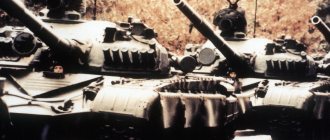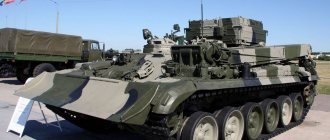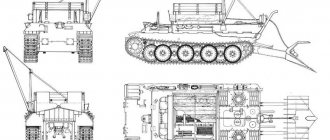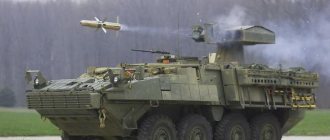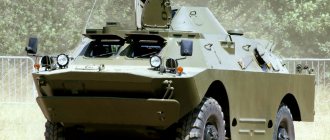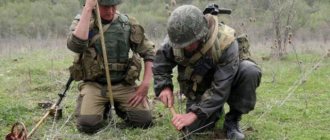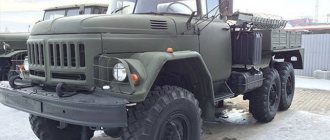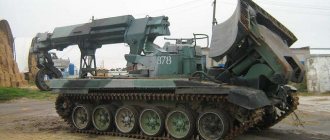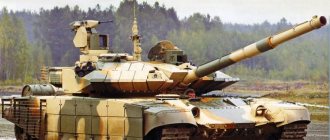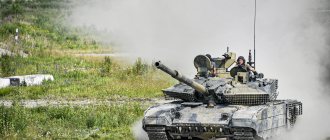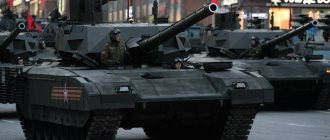BMR-3M, mine clearing combat vehicle
Company participant: Uralvagonzavod, Research and Production Corporation, JSC
BRM-3M is designed for reconnaissance, overcoming and clearing minefields, routes of movement of military columns, creating passages in minefields during enemy fire. "Vepr" has increased resistance to close explosions. Its technical capabilities make it possible to trawl mines installed in snow or soil, neutralize mines lying on the surface, and those equipped with radio fuses.
This vehicle creates passages in minefields for wheeled and tracked vehicles, the width of the wheels (caterpillars) and the inter-wheel (inter-track) distance approximately corresponds to that of a tank. If a passage is created in a field with anti-track mines with a pressure fuse, then the result of the operation of the BMR-3M is a pair of tracks with a width of 870 mm each (the unswept strip between them is 1620 mm). Anti-bottom mines with contact fuses are destroyed in a continuous strip, the width of which is 3200 mm, and if there are magnetic fuses - 6000-7000 mm.
Peculiarities.
The BMR-ZM "Vepr" is designed using the T-90 chassis, the armor of which has been significantly strengthened. It is equipped with a crew cabin, a cargo platform for placing trawls with a lifting capacity of up to 5 tons, a special lift, and remote control systems for trawling equipment and an anti-aircraft machine gun. The welded cabin has a commander's cupola with hatches, equipped with viewing devices, on which the ZPU is mounted. Roller-type trawl sections are placed on the loading platform behind the wheelhouse. The conning tower and the front part of the hull are additionally covered with the Kontakt-V dynamic protection complex, designed primarily to protect the BMR from anti-tank weapons. The bottom armor has also been strengthened from cellular to equal-strength. For camouflage, the BMR is equipped with a smoke exhaust system. In addition to the crew members, the fighting compartment can accommodate three more sappers, whose task is to completely clear the area and structures. The main components and assemblies are similar to those installed on the T-90 tank. In addition, the machine has a system that allows it to overcome water obstacles along the bottom. It includes an air supply pipe, emergency insulating gas masks and navigation equipment for underwater driving.
"Vepr" compares favorably with its predecessor BMR-3 "Kort-B" in the increased comfort and ergonomics of the crew's workplaces. Ventilation allows you to successfully perform combat missions even in the area where weapons of mass destruction are used or in conditions of heavy dust/smoke in the mine clearance zone without gas masks. The climate control system creates a comfortable temperature in the combat compartment at outside temperatures from -40 to +64 °C. There are supplies of food, water, a dry closet, a food warmer and a water heater. The autonomy of the Vepr crew is three days.
Design.
Demining is carried out by complexes of minesweepers of various designs. The main element is KMT-7, which is mounted in front of the machine on a special coupling and consists of two blade and two roller sections. This also includes an electromagnetic tank attachment for mine sweeping with proximity fuses, a multi-band radio interference transmitter RP-377 IV, which prevents the operation of mines with radio fuses, and a device for sweeping anti-bottom mines.
In the stowed position, the roller elements are loaded onto the platform (behind the wheelhouse). They are transferred to the combat position by a standard crane boom (crew) with a lifting capacity of up to 2500 kg. No need for a truck crane. To attach (dismantle) a trawl, it takes no more than 3 hours. For a sapper landing, the Vepr kit includes two sets of mine detectors, two individual protective kits for the Doublon sapper, a demining kit, wearable electromagnetic interference transmitters, individual communications equipment, etc. n. The use of units and systems of the T-90 tank in the design of the BMR-ZM initially solves the problems of providing this model of military equipment with spare parts and gives grounds to talk about the high reliability of the vehicle.
A closed-type ZPU with electromechanical control is used to repel an attack from the air, defend troops and protect vehicles. The machine gun is also used to shoot unexploded mines. In the rear wall of the superstructure and along its sides there are three loopholes for landing fire from service weapons.
The crew, in addition to the vehicle mounted anti-aircraft guns and smoke grenade launchers, has a transportable kit. It consists of an RPG-7D hand grenade launcher with six shots, two Igla anti-aircraft missiles, F-1 grenades (10 pcs.), and an AKS-74 assault rifle. The crew is armed with pistols, and the sappers are armed with standard weapons. Currently, the troops are receiving the newest version of the BMR-3MA vehicle (“object 197A”), unified in chassis and power plant with the T-90A tank. The machine is equipped with a trawl of a new design (continuous trawling) “Pavement”.
Specifications
| Weight with KMT-R3 trawl, t | 51 |
| Crew, people | 2 |
| Places for sapper landing | 3 |
| Engine | four-stroke, multi-fuel diesel V-84MS, 840 hp. |
| Armament | Autonomous, closed-type anti-aircraft machine gun installation with a 12.7 mm machine gun |
| Maximum speed, km/h | 60 |
| Overcoming water obstacles with OPV | width, m, up to 1000 depth, m, up to 5 |
| PROTECTION | - against conventional weapons, - bottom armor with increased mine resistance, - mounted remote protection, - deforming painting, - protection against weapons of mass destruction |
| EQUIPMENT | Trawling equipment: tracked mine trawl KMT-7 with an electromagnetic attachment Trawling speed, km/h 5...12 Loading platform, lifting capacity, t 5 Crane boom with manual drive, lifting capacity, t up to 2.5 Jamming transmitter for radio signal jamming p |
Video
Design
The general view of the missile launcher is a one-piece floating welded body with two launchers placed on top of it and the equipment necessary for launching. The crew consists of two people - a driver and a commander-operator.
The vehicle is made on the basis of the 2S1 Gvozdika self-propelled gun and, accordingly, is equipped with a completely identical body.
The power plant is YaMZ-238N, which is an eight-cylinder V-shaped 300-horsepower diesel engine, fuel consumption is 140 liters per 100 km. Chassis: torsion bar suspension. The machine moves on water by rotating the tracks. Dimensions of the UR-77 combat vehicle:
| Length, mm | 7860 |
| Width, mm | 2850 |
| Height, mm | 2545 |
| Base, mm | 3700 |
| Ground clearance, mm | 400 |
The only means of mine clearance that the installation has are UR-77 “Meteorite” rocket charges of different brands – UZ-67, UZP-77 and ZRSh.
This ammunition consists of a jet engine, behind which runs a long hose filled with an explosive substance (TNT, PVV-7 or TGAF-25). The length of the hose varies depending on the model used. The installation accommodates two such ammunition, and reloading is completed in 30-40 minutes.
"Checked: no mines"
Even Peter I noted in his decrees that a military engineer must be not only educated, but also courageous, since “this rank, more than any other, is exposed to danger.” This especially applies to the work of sapper engineers, who, as we know, make only one mistake. Special equipment is designed to help you avoid making an unfortunate mistake.
The BMR-3MA Vepr combat mine clearing vehicle, which recently began to enter service with the troops, was developed by the Ural Design Bureau of Transport Engineering (part of UVZ). Using a special trawl, moving at a speed of 5-12 km/h, it creates a safe road among the mines, just wide enough for the passage of tanks and other equipment.
BMR-3MA "Vepr" mine clearance combat vehicle. Photo: Ministry of Defense
Since the Vepr always goes ahead of the main troops and is the first to come under enemy fire, the vehicle is equipped with increased protection, including dynamic protection. In the standard version, the armored monster is controlled by two people, but the option of a completely unmanned complex is being considered.
According to the chief of the engineering troops of the Russian Armed Forces, Yuri Stavitsky, in 2020, Russian military engineers in Nagorno-Karabakh neutralized over 23 thousand explosive objects, and more than 6.5 thousand hectares of territory were cleared of mines in Syria. Work continues to eliminate shells from the Great Patriotic War on Russian territory. Experts estimate that tens of millions of mines in former hotspots around the world are buried underground and pose a danger. Thus, even in peacetime, military engineers will not be left without work for many years.
What minefields does the system create?
The system's missiles are made in two versions: anti-personnel and anti-tank. The system allows you to install combined minefields. Anti-tank and anti-personnel mines can be laid in such an order that the barrier becomes insurmountable for both riflemen and armored vehicles.
In this case, the mine, once in the ground, becomes irremovable, and it is almost impossible to neutralize it. In accordance with the Geneva Convention, each mine is equipped with remote self-destructors. With their help, the barrier can be quickly destroyed after the end of hostilities, which will help avoid civilian casualties. These same fuses will help blow up the entire field.
The youngest "Gorynych"
Now the new UR-07M “Resorting” installation is entering service with the army. This is the product of the work of the Research Engineering Institute in Balashikha and the Design Bureau of the Rubtsovsk Machine-Building Plant.
This installation contains two charges: one fires at 340 meters, and the second – up to a kilometer. This vehicle has steel armor, air conditioning and climate control systems, and a “Cloud” smoke screen system. Six 81 mm grenade launchers are built into the body. “Resorting” also floats, but faster – its speed is not 6 km/h, but 9 km/h. And this means that the new “Serpent Gorynych” is in many ways superior to the current one.
Where will it be used?
“Agriculture” is effective both when conducting maneuverable combat operations and in the fight against terrorists or protecting a long state border. As noted by the creators from the NPO "Splav" named after. Ganichev, the remote method of installing minefields has a number of advantages. In particular, it is distinguished by the speed of laying minefields, especially in hard-to-reach areas. At the same time, the ability of mines to deactivate or self-destruct at a given time ensures safe and rapid clearance of mines after the cessation of hostilities.
Russia has created the first aerial mining system against UAVs Read more
Performance characteristics and analogues
Only two countries in the world have truly competitive cars.
The only comparable model of such equipment in terms of characteristics is the American M58 “MICLIC” missile launcher, however, a significant drawback compared to the Russian model is that the installation is placed on a towed trailer and is not capable of moving independently.
As we can see from the comparison table, the UR-77 is inferior to its Western competitor only in terms of aisle width. However, this parameter depends solely on the type of charge, the improvement of which is only a matter of time for designers.
